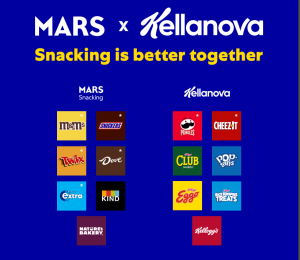 Mars, Inc., a family-owned, global leader in pet care, snacking and food, and Kellanova, a leading company in global snacking, international cereal and noodles, North American plant-based foods and frozen breakfast foods, have entered into a definitive agreement under which Mars has agreed to acquire Kellanova for $83.50 per share in cash, for a total consideration of $35.9 billion, including assumed net leverage. The transaction price represents a premium of approximately 44 percent to Kellanova’s unaffected 30-trading day volume weighted average price and a premium of approximately 33 percent to Kellanova’s unaffected 52-week high as of Aug. 2. The total consideration represents an acquisition multiple of 16.4x LTM adjusted EBITDA as of June 29.
Mars, Inc., a family-owned, global leader in pet care, snacking and food, and Kellanova, a leading company in global snacking, international cereal and noodles, North American plant-based foods and frozen breakfast foods, have entered into a definitive agreement under which Mars has agreed to acquire Kellanova for $83.50 per share in cash, for a total consideration of $35.9 billion, including assumed net leverage. The transaction price represents a premium of approximately 44 percent to Kellanova’s unaffected 30-trading day volume weighted average price and a premium of approximately 33 percent to Kellanova’s unaffected 52-week high as of Aug. 2. The total consideration represents an acquisition multiple of 16.4x LTM adjusted EBITDA as of June 29.
Kellanova is home to iconic snacking brands including Pringles, Cheez-It, Pop-Tarts, Rice Krispies Treats, NutriGrain and RXBAR, as well as cherished food brands including Kellogg’s (international), Eggo and MorningStar Farms. With roots dating back more than 100 years, Kellanova has a rich legacy of quality and innovation. Kellanova had 2023 Net Sales of more than $13 billion, with a presence in 180 markets and approximately 23,000 employees.
Kellanova’s portfolio complements the existing Mars portfolio, which includes billion-dollar snacking and confectionery brands like SNICKERS®, M&M’S®, TWIX, DOVE and EXTRA, as well as KIND and Nature’s Bakery. Mars also has 10 pet care brands with over $1 billion in sales, including ROYAL CANIN, VCA, PEDIGREE, BANFIELD, WHISKAS, BLUEPEARL, CESAR, SHEBA, ANICURA and IAMS. With more than 150,000 Associates across its Petcare, Snacking and Food businesses, Mars had 2023 Net Sales of more than $50 billion.
Poul Weihrauch, CEO and president of Mars, Incorporated, said: “In welcoming Kellanova’s portfolio of growing global brands, we have a substantial opportunity for Mars to further develop a sustainable snacking business that is fit for the future. We will honor the heritage and innovation behind Kellanova’s incredible snacking and food brands while combining our respective strengths to deliver more choice and innovation to consumers and customers. We have tremendous respect for the storied legacy that Kellanova has built and look forward to welcoming the Kellanova team.”
Steve Cahillane, chairman, president and CEO of Kellanova, added: “This is a truly historic combination with a compelling cultural and strategic fit. Kellanova has been on a transformation journey to become the world’s best snacking company, and this opportunity to join Mars enables us to accelerate the realization of our full potential and our vision. The transaction maximizes shareholder value through an all-cash transaction at an attractive purchase price and creates new and exciting opportunities for our employees, customers, and suppliers. We are excited for Kellanova’s next chapter as part of Mars, which will bring together both companies’ world-class talent and capabilities and our shared commitment to helping our communities thrive. With a proven track record of successfully and sustainably nurturing and growing acquired businesses, we are confident Mars is a natural home for the Kellanova brands and employees.”
Snacking is a large, attractive and durable category that continues to grow in importance with consumers. Upon completion of the transaction, Kellanova will become part of Mars Snacking, led by Global President Andrew Clarke and headquartered in Chicago, allowing Mars to bring even more beloved brands to more consumers globally. Mars intends to apply its proven brand-building approach to further nurture and grow Kellanova’s brands, including accelerating innovation to meet evolving consumer tastes and preferences, investing locally to expand reach and introducing more better-for-you nutrition options to meet evolving consumer needs.
Clarke said, “This is an exciting opportunity to create a broader, global snacking business, allowing Kellanova and Mars Snacking to both achieve their full potential.
Kellanova and Mars share long histories of building globally recognized and beloved brands. The Kellanova brands significantly expand our Snacking platform, allowing us to even more effectively meet consumer needs and drive profitable business growth. Our complementary portfolios, routes-to-market and R&D capabilities will unleash enhanced consumer-centric innovation to shape the future of responsible snacking.”
Transaction Advances Strategic Vision for the Future of Snacking
- Accelerates ambition to double Mars Snacking in the next decade, in alignment with global consumer demand trends. The addition of Kellanova provides Mars Snacking with entry into new attractive snacking categories. It will add two new billion-dollar brands – Pringles and Cheez-It – to the Mars business, which today includes 15 billion-dollar brands. It will also expand the Mars health & wellness Snacking portfolio with the addition of new complementary products like RXBAR and NutriGrain to reflect global trends and preferences. With this transaction, Mars can extend its commitment to nourishing wellbeing through an expanded global reach and diversified product portfolio to meet evolving consumer tastes and demands.
- Enhances portfolio with addition of unique, category-leading and growing brands. Kellanova’s differentiated brand portfolio is defined by uniqueness, delivering category leadership and spring-loaded platforms for future growth. The majority of Kellanova snacking brands outperform category competitors, particularly among Gen Z and Millennial consumers.
- Delivers stronger, differentiated portfolio and distribution platform for priority international markets. Kellanova’s globally recognized portfolio includes beloved and growing brands with untapped potential. The combined portfolio will be well-suited to meet consumer demands for a variety of tastes and price points in fast-growing geographies, including Africa and Latin America, through complementary routes-to-market, supply chains and local operations.
- Brings together world-class talent with leading brand-building experience. Both Mars and Kellanova have portfolios of some of the world’s most iconic brands, all of which have been nurtured and grown by world-class talent with deep expertise. The acquisition of Kellanova by Mars will enable each company’s talent base to take advantage of greater combined resources and professional development opportunities, given the complementary nature of the broader family of brands.
- Combines complementary capabilities to unlock growth and consumer-centric innovation. The addition of Kellanova’s R&D capabilities will enable the combined business to share best practices in brand building, deliver enhanced digital capabilities, unlock complementary channel strengths and advance brand ecosystems and immersions.
- Enhances positive societal impact of strong sustainability efforts. Kellanova has a long history of social and environmental leadership, including its Better Days Promise initiative, complementing the Mars Sustainable in a Generation Plan, which has delivered tangible progress, as reflected in its latest Sustainability Report, which documented strong decoupling of business growth from greenhouse gas emissions. Kellanova will also become part of the Mars Net Zero commitment and align with the Mars Responsible Marketing code.
Under the terms of the agreement, Mars will acquire all outstanding equity of Kellanova for $83.50 per share in cash, representing a total enterprise value of $35.9 billion. All of Kellanova’s brands, assets and operations, including its snacking brands, portfolio of international cereal and noodles, North American plant-based foods and frozen breakfast are included in the transaction.Mars intends to fully finance the acquisition through a combination of cash-on-hand and new debt, for which commitments have been secured.
The agreement has been unanimously approved by the Board of Directors of Kellanova. The transaction is subject to Kellanova shareholder approval and other customary closing conditions, including regulatory approvals, and is expected to close within the first half of 2025. The transaction agreement permits Kellanova to declare and pay quarterly dividends consistent with historical practice prior to the closing of the transaction.
The W.K. Kellogg Foundation Trust and the Gund Family have entered into agreements pursuant to which they have committed to vote shares representing 20.7% of Kellanova’s common stock, as of Aug. 9, in favor of the transaction.
After closing, Battle Creek, Mich., will remain a core location for the combined organization.
For more news of interest to the snacks industry, subscribe to Gourmet News.
 The Institute for Justice, a nonprofit, public interest law firm, filed a lawsuit challenging a newly enacted Florida law that bans the production, distribution, and sale of cultivated meat, which allows consumers to enjoy the taste of meat grown directly from real animal cells, without the need to raise or kill animals.
The Institute for Justice, a nonprofit, public interest law firm, filed a lawsuit challenging a newly enacted Florida law that bans the production, distribution, and sale of cultivated meat, which allows consumers to enjoy the taste of meat grown directly from real animal cells, without the need to raise or kill animals.










